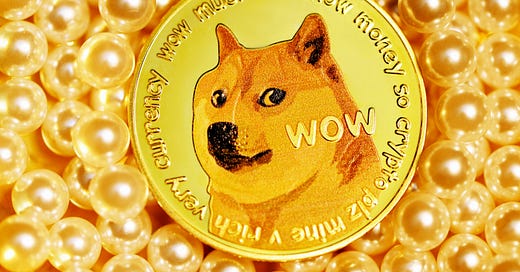Dogecoin: A Series – Part 1
Who let the doge out!? On the social construction of a cryptocurrency
On November 27th, 2013, software engineer Jackson Palmer tweeted: “Investing in Dogecoin, pretty sure it’s the next big thing.”
But, this tweet was a joke. There was no Dogecoin. Still, the tweet caught the attention of another software engineer, Billy Markus, who reached out to Palmer, and together, they turned the joke into reality.
Dogecoin was born on December 6th.
Dogecoin is generally considered the first “memecoin.” In his 1976 book The Selfish Gene, Richard Dawkins introduced the term “meme.” Per Dawkins, a meme is an idea that moves between people in a culture. Just as genes move between people biologically, memes move between people culturally: “We are built as gene machines and cultured as meme machines,” he wrote.
When social media arose, people applied this concept to images and ideas that go viral online. Memes are the vehicles of cultural transmission online.
In the cryptocurrency world, a memecoin — like an Internet meme — depends on cultural relevance, capitalizing on something with Internet virality. It could be a joke, an image, or a trend. Memecoins are of a moment and for a moment. They are not typically intended for a specific financial use case, so as scholar Albi Nani notes, any financial value a memecoin obtains “works symbiotically” with its cultural value.
Dogecoin’s cultural value comes from its connection with the doge meme. The “doge meme” is a photo of a Shiba Inu dog covered with grammatically incorrect text (e.g., “much charity”; “such mint”). The meme format dates back to 2010, when it first appeared in the Shiba Confessions Tumblr blog, and the term “doge” comes from a 2005 YouTube video from Homestar Runner that intentionally mispronounced “dog.” Combine the cute photo with some Comic Sans text and a funny pronunciation of “dog,” and you get something silly, fun, quirky, and friendly. It went viral.
According to scholars Trevor Pinch and Wiebe Bijker, technologies like Dogecoin are socially constructed. What a technology is used for is not pre-determined. It’s figured out over time by many different social groups with different interpretations of what to do with the technology. Each group has its own frame of reference, and this frame is the lens through which the group determines the use cases for the technology.
In other words, the same technology can mean different things to different groups of users. For example, for one person, a truck can be a way to drive to school, and for another, a truck can be a way to pull a plow in a field. The same technology can hold different meanings.
Because of these different interpretations, technologies have an “interpretative flexibility.” There is, at least when a technology is first introduced, rarely a single interpretation of how best to use it. This is what we see in the case of Dogecoin. In its early years, the value of Dogecoin was open to interpretation, and there was often disagreement: What is this memecoin good for?
There are four main social groups that shaped Dogecoin, each with its own interpretation of the cryptocurrency: (1) The founders, interested in creating a parody of cryptocurrency, developed a coin with no practical applications. (2) Early adopters (tippers) used the coin for social media tipping, reflecting an interest in building community. (3) Later adopters (pump and dumpers), interested in getting rich quickly, developed moneymaking schemes for the coin. (4) Crypto-tastemakers like Elon Musk and Mark Cuban embraced the coin to build cultural cache and personal brand.
Over time, a technology’s interpretative flexibility diminishes; some interpretations win out over others, and the collective meaning of a technology converges. But, in those early years, interpretations and use cases abound as people try to make sense of something new.
That’s exactly what happened with Dogecoin, and over the next six posts, I’m going to look closely at these four social groups and their interpretations of Dogecoin.
This is the story of the original memecoin and the people who constructed it.
Sources.
Jenny Noyes, “An Interview With The Creator Of Dogecoin: The Internet’s Favourite New Currency,” Junkee, January 22, 2014, https://junkee.com/an-interview-with-the-inventor-of-dogecoin-the-internets-favourite-new-currency/27411.
Noyes; Stephen Hutcheon, “The Rise and Rise of Dogecoin, the Internet’s Hottest Cryptocurrency,” The Sydney Morning Herald, January 24, 2014.
Richard Dawkins, The Selfish Gene (Oxford university press, 2016).
Dan Ashmore, “What Are Meme Coins? Are They Worth Investing In? – Forbes Advisor,” Forbes, August 4, 2022.
Albi Nani, “The Doge Worth 88 Billion Dollars: A Case Study of Dogecoin,” Convergence 28, no. 6 (2022): 1719–36.
Benjamin Powers and Daniel Kuhn, “‘It’s Part and Parcel of Crypto’: How Memes Drive Narrative and Value,” August 26, 2020.
Kyle Chayka, “Wow This Is Doge,” The Verge, December 31, 2013.
Forrest Wickman, “How Do You Pronounce ‘Doge’?,” Slate Magazine, November 15, 2013.
Trevor J Pinch and Wiebe E Bijker, “The Social Construction of Facts and Artefacts: Or How the Sociology of Science and the Sociology of Technology Might Benefit Each Other,” Social Studies of Science 14, no. 3 (1984): 399–441.
Ronald Kline and Trevor Pinch, “Users as Agents of Technological Change: The Social Construction of the Automobile in the Rural United States,” Technology and Culture 37, no. 4 (1996): 763–95.
Wiebe E. Bijker, “How Is Technology Made?—That Is the Question!,” Cambridge Journal of Economics 34, no. 1 (2010): 63–76; Hans K Klein and Daniel Lee Kleinman, “The Social Construction of Technology: Structural Considerations,” Science, Technology, & Human Values 27, no. 1 (2002): 28–52.
Kline and Pinch, “Users as Agents of Technological Change: The Social Construction of the Automobile in the Rural United States.”
These posts are adapted from an academic paper I wrote in December 2023. I use historically accurate language where relevant; for example, I refer to the social media platform X as “Twitter” because that was its name when Dogecoin was introduced.







This is really interesting! I look forward to the other posts because I really don’t understand crypto.